Transactional and Transformational Leadership: A Case Study of Apple Inc.
VerifiedAdded on 2023/06/07
|8
|2168
|468
AI Summary
This case study compares the transactional and transformational leadership styles of John Sculley and Steve Jobs at Apple Inc. and their impact on the company's financial status. It also discusses the success of Apple Inc. and the leadership styles of the two leaders.
Contribute Materials
Your contribution can guide someone’s learning journey. Share your
documents today.

[Leadership]
Secure Best Marks with AI Grader
Need help grading? Try our AI Grader for instant feedback on your assignments.
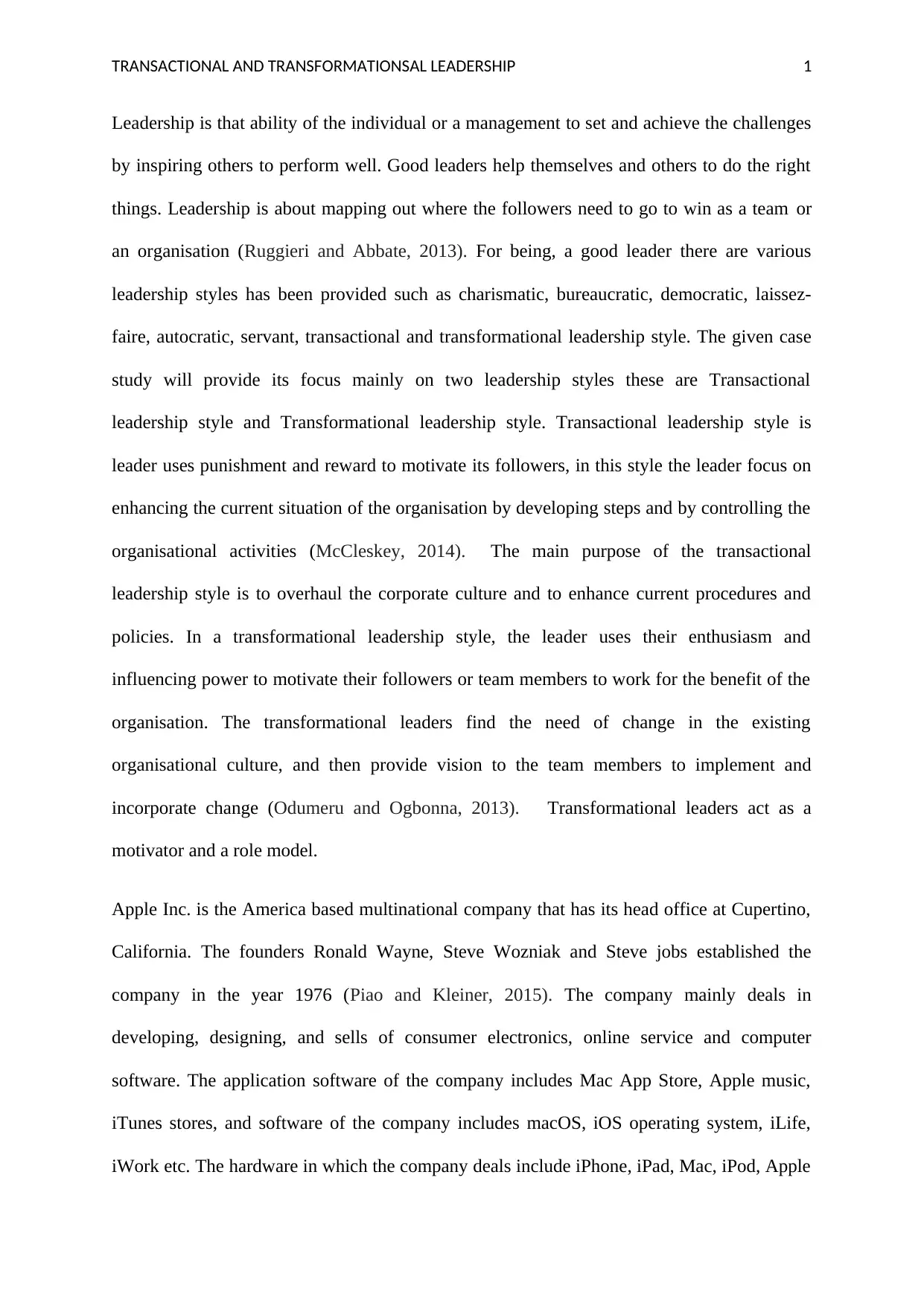
TRANSACTIONAL AND TRANSFORMATIONSAL LEADERSHIP 1
Leadership is that ability of the individual or a management to set and achieve the challenges
by inspiring others to perform well. Good leaders help themselves and others to do the right
things. Leadership is about mapping out where the followers need to go to win as a team or
an organisation (Ruggieri and Abbate, 2013). For being, a good leader there are various
leadership styles has been provided such as charismatic, bureaucratic, democratic, laissez-
faire, autocratic, servant, transactional and transformational leadership style. The given case
study will provide its focus mainly on two leadership styles these are Transactional
leadership style and Transformational leadership style. Transactional leadership style is
leader uses punishment and reward to motivate its followers, in this style the leader focus on
enhancing the current situation of the organisation by developing steps and by controlling the
organisational activities (McCleskey, 2014). The main purpose of the transactional
leadership style is to overhaul the corporate culture and to enhance current procedures and
policies. In a transformational leadership style, the leader uses their enthusiasm and
influencing power to motivate their followers or team members to work for the benefit of the
organisation. The transformational leaders find the need of change in the existing
organisational culture, and then provide vision to the team members to implement and
incorporate change (Odumeru and Ogbonna, 2013). Transformational leaders act as a
motivator and a role model.
Apple Inc. is the America based multinational company that has its head office at Cupertino,
California. The founders Ronald Wayne, Steve Wozniak and Steve jobs established the
company in the year 1976 (Piao and Kleiner, 2015). The company mainly deals in
developing, designing, and sells of consumer electronics, online service and computer
software. The application software of the company includes Mac App Store, Apple music,
iTunes stores, and software of the company includes macOS, iOS operating system, iLife,
iWork etc. The hardware in which the company deals include iPhone, iPad, Mac, iPod, Apple
Leadership is that ability of the individual or a management to set and achieve the challenges
by inspiring others to perform well. Good leaders help themselves and others to do the right
things. Leadership is about mapping out where the followers need to go to win as a team or
an organisation (Ruggieri and Abbate, 2013). For being, a good leader there are various
leadership styles has been provided such as charismatic, bureaucratic, democratic, laissez-
faire, autocratic, servant, transactional and transformational leadership style. The given case
study will provide its focus mainly on two leadership styles these are Transactional
leadership style and Transformational leadership style. Transactional leadership style is
leader uses punishment and reward to motivate its followers, in this style the leader focus on
enhancing the current situation of the organisation by developing steps and by controlling the
organisational activities (McCleskey, 2014). The main purpose of the transactional
leadership style is to overhaul the corporate culture and to enhance current procedures and
policies. In a transformational leadership style, the leader uses their enthusiasm and
influencing power to motivate their followers or team members to work for the benefit of the
organisation. The transformational leaders find the need of change in the existing
organisational culture, and then provide vision to the team members to implement and
incorporate change (Odumeru and Ogbonna, 2013). Transformational leaders act as a
motivator and a role model.
Apple Inc. is the America based multinational company that has its head office at Cupertino,
California. The founders Ronald Wayne, Steve Wozniak and Steve jobs established the
company in the year 1976 (Piao and Kleiner, 2015). The company mainly deals in
developing, designing, and sells of consumer electronics, online service and computer
software. The application software of the company includes Mac App Store, Apple music,
iTunes stores, and software of the company includes macOS, iOS operating system, iLife,
iWork etc. The hardware in which the company deals include iPhone, iPad, Mac, iPod, Apple
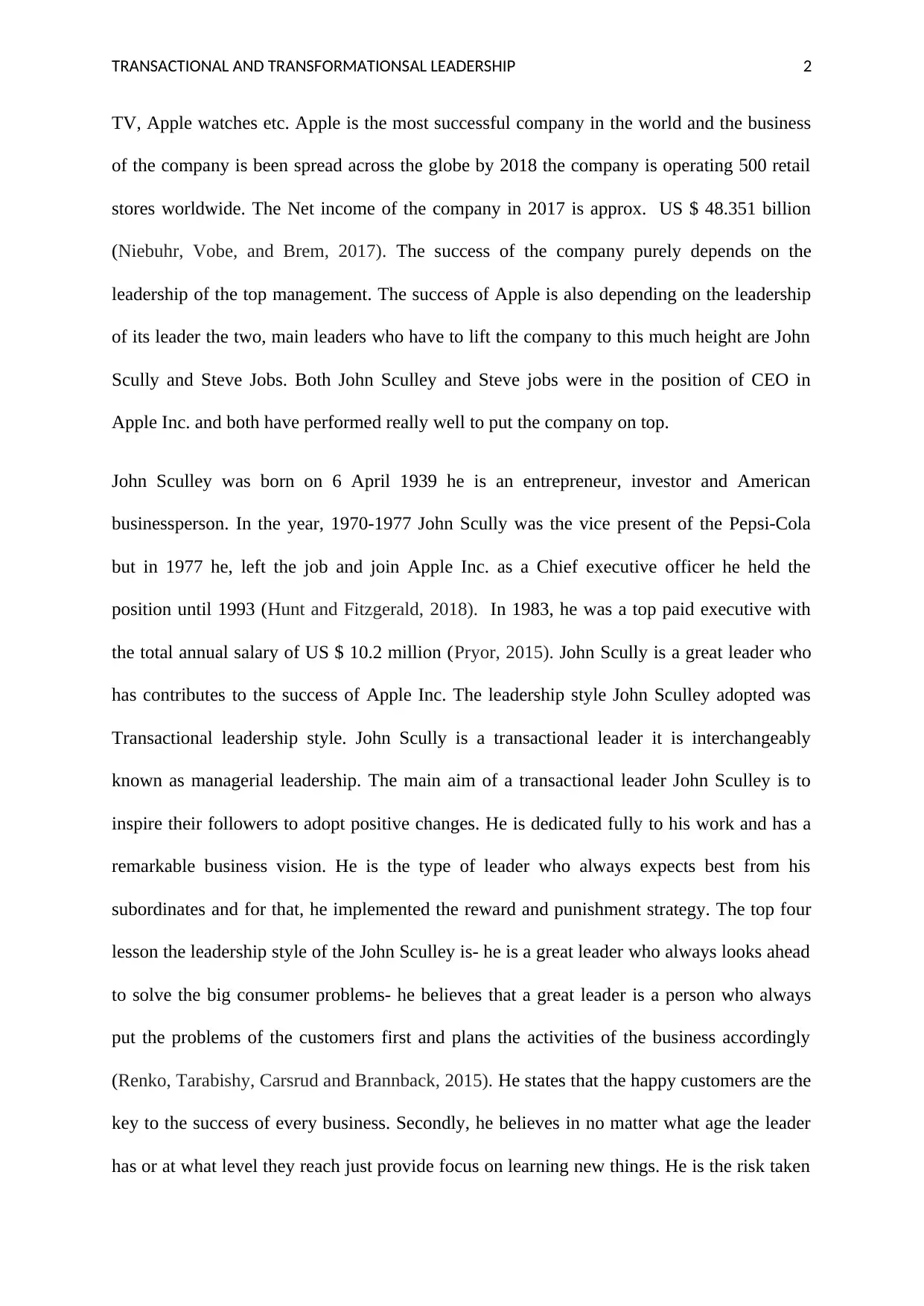
TRANSACTIONAL AND TRANSFORMATIONSAL LEADERSHIP 2
TV, Apple watches etc. Apple is the most successful company in the world and the business
of the company is been spread across the globe by 2018 the company is operating 500 retail
stores worldwide. The Net income of the company in 2017 is approx. US $ 48.351 billion
(Niebuhr, Vobe, and Brem, 2017). The success of the company purely depends on the
leadership of the top management. The success of Apple is also depending on the leadership
of its leader the two, main leaders who have to lift the company to this much height are John
Scully and Steve Jobs. Both John Sculley and Steve jobs were in the position of CEO in
Apple Inc. and both have performed really well to put the company on top.
John Sculley was born on 6 April 1939 he is an entrepreneur, investor and American
businessperson. In the year, 1970-1977 John Scully was the vice present of the Pepsi-Cola
but in 1977 he, left the job and join Apple Inc. as a Chief executive officer he held the
position until 1993 (Hunt and Fitzgerald, 2018). In 1983, he was a top paid executive with
the total annual salary of US $ 10.2 million (Pryor, 2015). John Scully is a great leader who
has contributes to the success of Apple Inc. The leadership style John Sculley adopted was
Transactional leadership style. John Scully is a transactional leader it is interchangeably
known as managerial leadership. The main aim of a transactional leader John Sculley is to
inspire their followers to adopt positive changes. He is dedicated fully to his work and has a
remarkable business vision. He is the type of leader who always expects best from his
subordinates and for that, he implemented the reward and punishment strategy. The top four
lesson the leadership style of the John Sculley is- he is a great leader who always looks ahead
to solve the big consumer problems- he believes that a great leader is a person who always
put the problems of the customers first and plans the activities of the business accordingly
(Renko, Tarabishy, Carsrud and Brannback, 2015). He states that the happy customers are the
key to the success of every business. Secondly, he believes in no matter what age the leader
has or at what level they reach just provide focus on learning new things. He is the risk taken
TV, Apple watches etc. Apple is the most successful company in the world and the business
of the company is been spread across the globe by 2018 the company is operating 500 retail
stores worldwide. The Net income of the company in 2017 is approx. US $ 48.351 billion
(Niebuhr, Vobe, and Brem, 2017). The success of the company purely depends on the
leadership of the top management. The success of Apple is also depending on the leadership
of its leader the two, main leaders who have to lift the company to this much height are John
Scully and Steve Jobs. Both John Sculley and Steve jobs were in the position of CEO in
Apple Inc. and both have performed really well to put the company on top.
John Sculley was born on 6 April 1939 he is an entrepreneur, investor and American
businessperson. In the year, 1970-1977 John Scully was the vice present of the Pepsi-Cola
but in 1977 he, left the job and join Apple Inc. as a Chief executive officer he held the
position until 1993 (Hunt and Fitzgerald, 2018). In 1983, he was a top paid executive with
the total annual salary of US $ 10.2 million (Pryor, 2015). John Scully is a great leader who
has contributes to the success of Apple Inc. The leadership style John Sculley adopted was
Transactional leadership style. John Scully is a transactional leader it is interchangeably
known as managerial leadership. The main aim of a transactional leader John Sculley is to
inspire their followers to adopt positive changes. He is dedicated fully to his work and has a
remarkable business vision. He is the type of leader who always expects best from his
subordinates and for that, he implemented the reward and punishment strategy. The top four
lesson the leadership style of the John Sculley is- he is a great leader who always looks ahead
to solve the big consumer problems- he believes that a great leader is a person who always
put the problems of the customers first and plans the activities of the business accordingly
(Renko, Tarabishy, Carsrud and Brannback, 2015). He states that the happy customers are the
key to the success of every business. Secondly, he believes in no matter what age the leader
has or at what level they reach just provide focus on learning new things. He is the risk taken
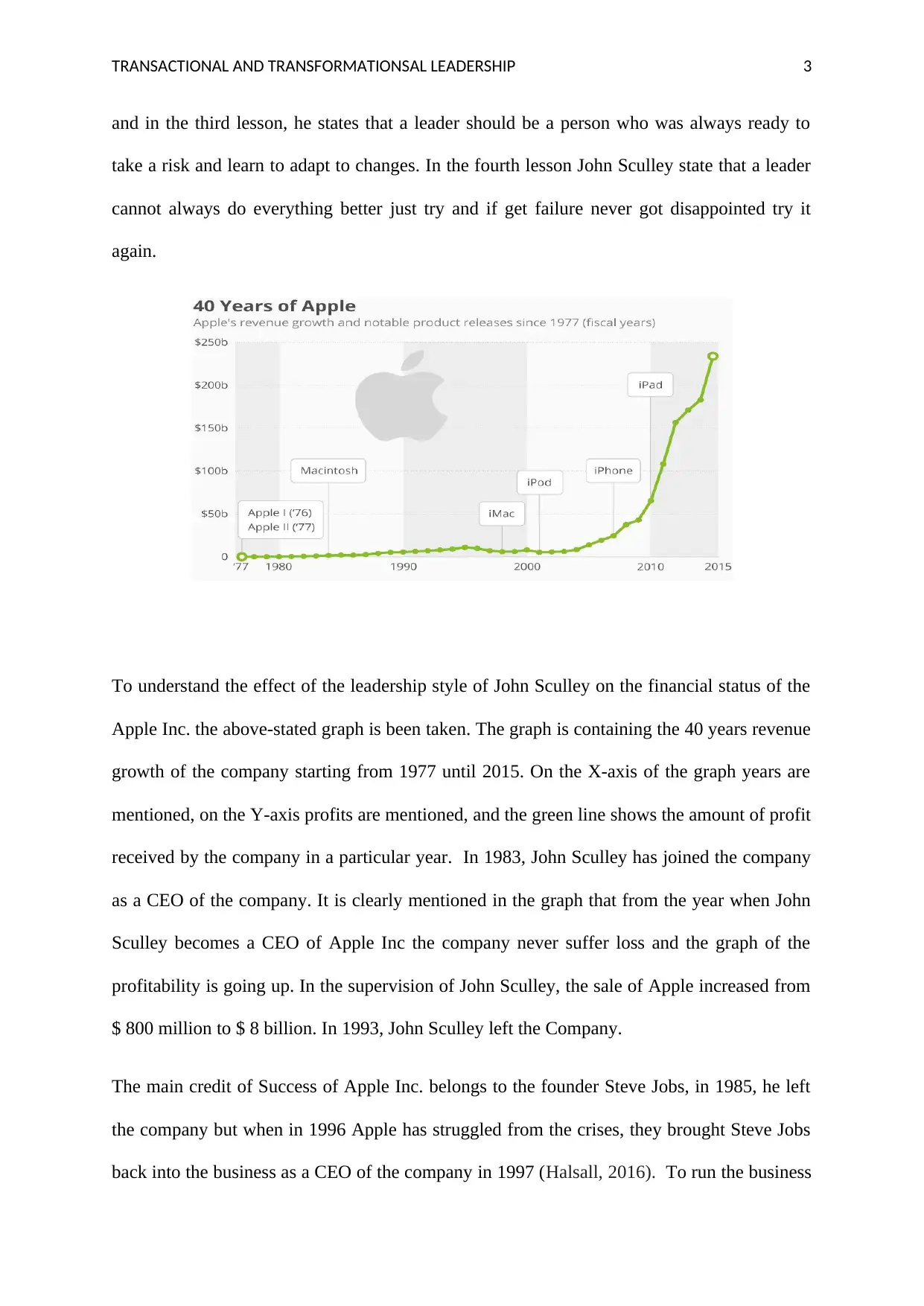
TRANSACTIONAL AND TRANSFORMATIONSAL LEADERSHIP 3
and in the third lesson, he states that a leader should be a person who was always ready to
take a risk and learn to adapt to changes. In the fourth lesson John Sculley state that a leader
cannot always do everything better just try and if get failure never got disappointed try it
again.
To understand the effect of the leadership style of John Sculley on the financial status of the
Apple Inc. the above-stated graph is been taken. The graph is containing the 40 years revenue
growth of the company starting from 1977 until 2015. On the X-axis of the graph years are
mentioned, on the Y-axis profits are mentioned, and the green line shows the amount of profit
received by the company in a particular year. In 1983, John Sculley has joined the company
as a CEO of the company. It is clearly mentioned in the graph that from the year when John
Sculley becomes a CEO of Apple Inc the company never suffer loss and the graph of the
profitability is going up. In the supervision of John Sculley, the sale of Apple increased from
$ 800 million to $ 8 billion. In 1993, John Sculley left the Company.
The main credit of Success of Apple Inc. belongs to the founder Steve Jobs, in 1985, he left
the company but when in 1996 Apple has struggled from the crises, they brought Steve Jobs
back into the business as a CEO of the company in 1997 (Halsall, 2016). To run the business
and in the third lesson, he states that a leader should be a person who was always ready to
take a risk and learn to adapt to changes. In the fourth lesson John Sculley state that a leader
cannot always do everything better just try and if get failure never got disappointed try it
again.
To understand the effect of the leadership style of John Sculley on the financial status of the
Apple Inc. the above-stated graph is been taken. The graph is containing the 40 years revenue
growth of the company starting from 1977 until 2015. On the X-axis of the graph years are
mentioned, on the Y-axis profits are mentioned, and the green line shows the amount of profit
received by the company in a particular year. In 1983, John Sculley has joined the company
as a CEO of the company. It is clearly mentioned in the graph that from the year when John
Sculley becomes a CEO of Apple Inc the company never suffer loss and the graph of the
profitability is going up. In the supervision of John Sculley, the sale of Apple increased from
$ 800 million to $ 8 billion. In 1993, John Sculley left the Company.
The main credit of Success of Apple Inc. belongs to the founder Steve Jobs, in 1985, he left
the company but when in 1996 Apple has struggled from the crises, they brought Steve Jobs
back into the business as a CEO of the company in 1997 (Halsall, 2016). To run the business
Secure Best Marks with AI Grader
Need help grading? Try our AI Grader for instant feedback on your assignments.
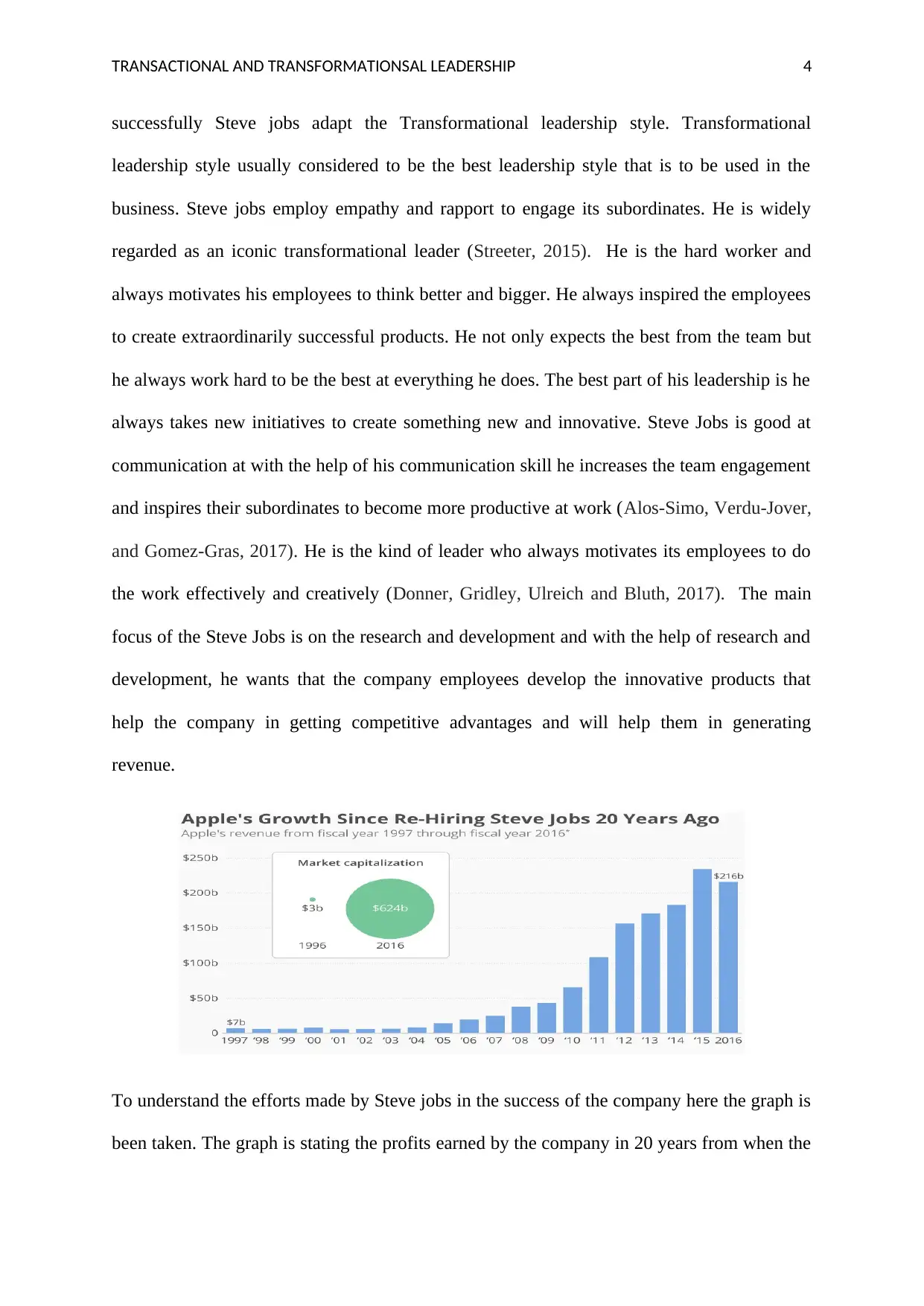
TRANSACTIONAL AND TRANSFORMATIONSAL LEADERSHIP 4
successfully Steve jobs adapt the Transformational leadership style. Transformational
leadership style usually considered to be the best leadership style that is to be used in the
business. Steve jobs employ empathy and rapport to engage its subordinates. He is widely
regarded as an iconic transformational leader (Streeter, 2015). He is the hard worker and
always motivates his employees to think better and bigger. He always inspired the employees
to create extraordinarily successful products. He not only expects the best from the team but
he always work hard to be the best at everything he does. The best part of his leadership is he
always takes new initiatives to create something new and innovative. Steve Jobs is good at
communication at with the help of his communication skill he increases the team engagement
and inspires their subordinates to become more productive at work (Alos-Simo, Verdu-Jover,
and Gomez-Gras, 2017). He is the kind of leader who always motivates its employees to do
the work effectively and creatively (Donner, Gridley, Ulreich and Bluth, 2017). The main
focus of the Steve Jobs is on the research and development and with the help of research and
development, he wants that the company employees develop the innovative products that
help the company in getting competitive advantages and will help them in generating
revenue.
To understand the efforts made by Steve jobs in the success of the company here the graph is
been taken. The graph is stating the profits earned by the company in 20 years from when the
successfully Steve jobs adapt the Transformational leadership style. Transformational
leadership style usually considered to be the best leadership style that is to be used in the
business. Steve jobs employ empathy and rapport to engage its subordinates. He is widely
regarded as an iconic transformational leader (Streeter, 2015). He is the hard worker and
always motivates his employees to think better and bigger. He always inspired the employees
to create extraordinarily successful products. He not only expects the best from the team but
he always work hard to be the best at everything he does. The best part of his leadership is he
always takes new initiatives to create something new and innovative. Steve Jobs is good at
communication at with the help of his communication skill he increases the team engagement
and inspires their subordinates to become more productive at work (Alos-Simo, Verdu-Jover,
and Gomez-Gras, 2017). He is the kind of leader who always motivates its employees to do
the work effectively and creatively (Donner, Gridley, Ulreich and Bluth, 2017). The main
focus of the Steve Jobs is on the research and development and with the help of research and
development, he wants that the company employees develop the innovative products that
help the company in getting competitive advantages and will help them in generating
revenue.
To understand the efforts made by Steve jobs in the success of the company here the graph is
been taken. The graph is stating the profits earned by the company in 20 years from when the
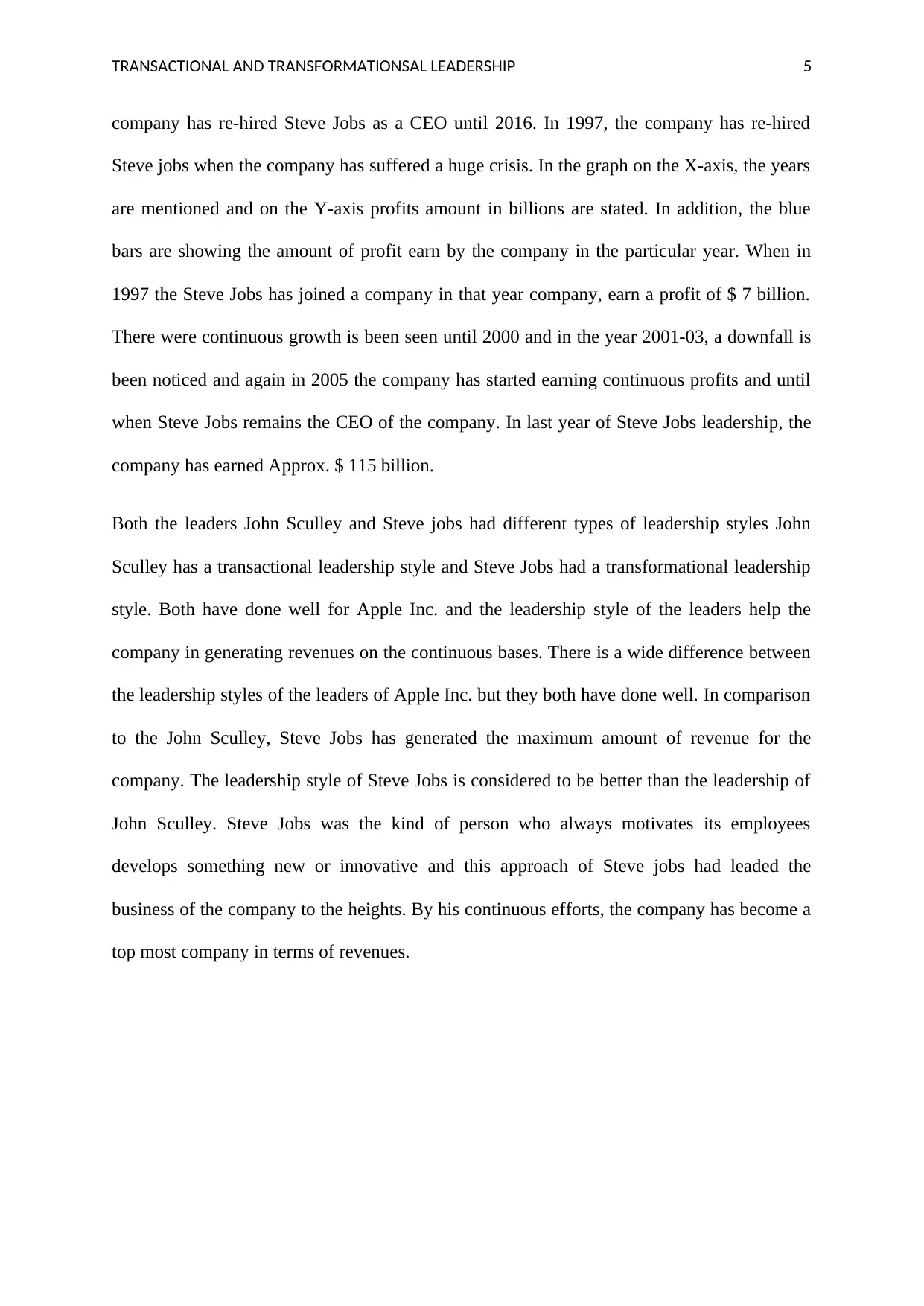
TRANSACTIONAL AND TRANSFORMATIONSAL LEADERSHIP 5
company has re-hired Steve Jobs as a CEO until 2016. In 1997, the company has re-hired
Steve jobs when the company has suffered a huge crisis. In the graph on the X-axis, the years
are mentioned and on the Y-axis profits amount in billions are stated. In addition, the blue
bars are showing the amount of profit earn by the company in the particular year. When in
1997 the Steve Jobs has joined a company in that year company, earn a profit of $ 7 billion.
There were continuous growth is been seen until 2000 and in the year 2001-03, a downfall is
been noticed and again in 2005 the company has started earning continuous profits and until
when Steve Jobs remains the CEO of the company. In last year of Steve Jobs leadership, the
company has earned Approx. $ 115 billion.
Both the leaders John Sculley and Steve jobs had different types of leadership styles John
Sculley has a transactional leadership style and Steve Jobs had a transformational leadership
style. Both have done well for Apple Inc. and the leadership style of the leaders help the
company in generating revenues on the continuous bases. There is a wide difference between
the leadership styles of the leaders of Apple Inc. but they both have done well. In comparison
to the John Sculley, Steve Jobs has generated the maximum amount of revenue for the
company. The leadership style of Steve Jobs is considered to be better than the leadership of
John Sculley. Steve Jobs was the kind of person who always motivates its employees
develops something new or innovative and this approach of Steve jobs had leaded the
business of the company to the heights. By his continuous efforts, the company has become a
top most company in terms of revenues.
company has re-hired Steve Jobs as a CEO until 2016. In 1997, the company has re-hired
Steve jobs when the company has suffered a huge crisis. In the graph on the X-axis, the years
are mentioned and on the Y-axis profits amount in billions are stated. In addition, the blue
bars are showing the amount of profit earn by the company in the particular year. When in
1997 the Steve Jobs has joined a company in that year company, earn a profit of $ 7 billion.
There were continuous growth is been seen until 2000 and in the year 2001-03, a downfall is
been noticed and again in 2005 the company has started earning continuous profits and until
when Steve Jobs remains the CEO of the company. In last year of Steve Jobs leadership, the
company has earned Approx. $ 115 billion.
Both the leaders John Sculley and Steve jobs had different types of leadership styles John
Sculley has a transactional leadership style and Steve Jobs had a transformational leadership
style. Both have done well for Apple Inc. and the leadership style of the leaders help the
company in generating revenues on the continuous bases. There is a wide difference between
the leadership styles of the leaders of Apple Inc. but they both have done well. In comparison
to the John Sculley, Steve Jobs has generated the maximum amount of revenue for the
company. The leadership style of Steve Jobs is considered to be better than the leadership of
John Sculley. Steve Jobs was the kind of person who always motivates its employees
develops something new or innovative and this approach of Steve jobs had leaded the
business of the company to the heights. By his continuous efforts, the company has become a
top most company in terms of revenues.
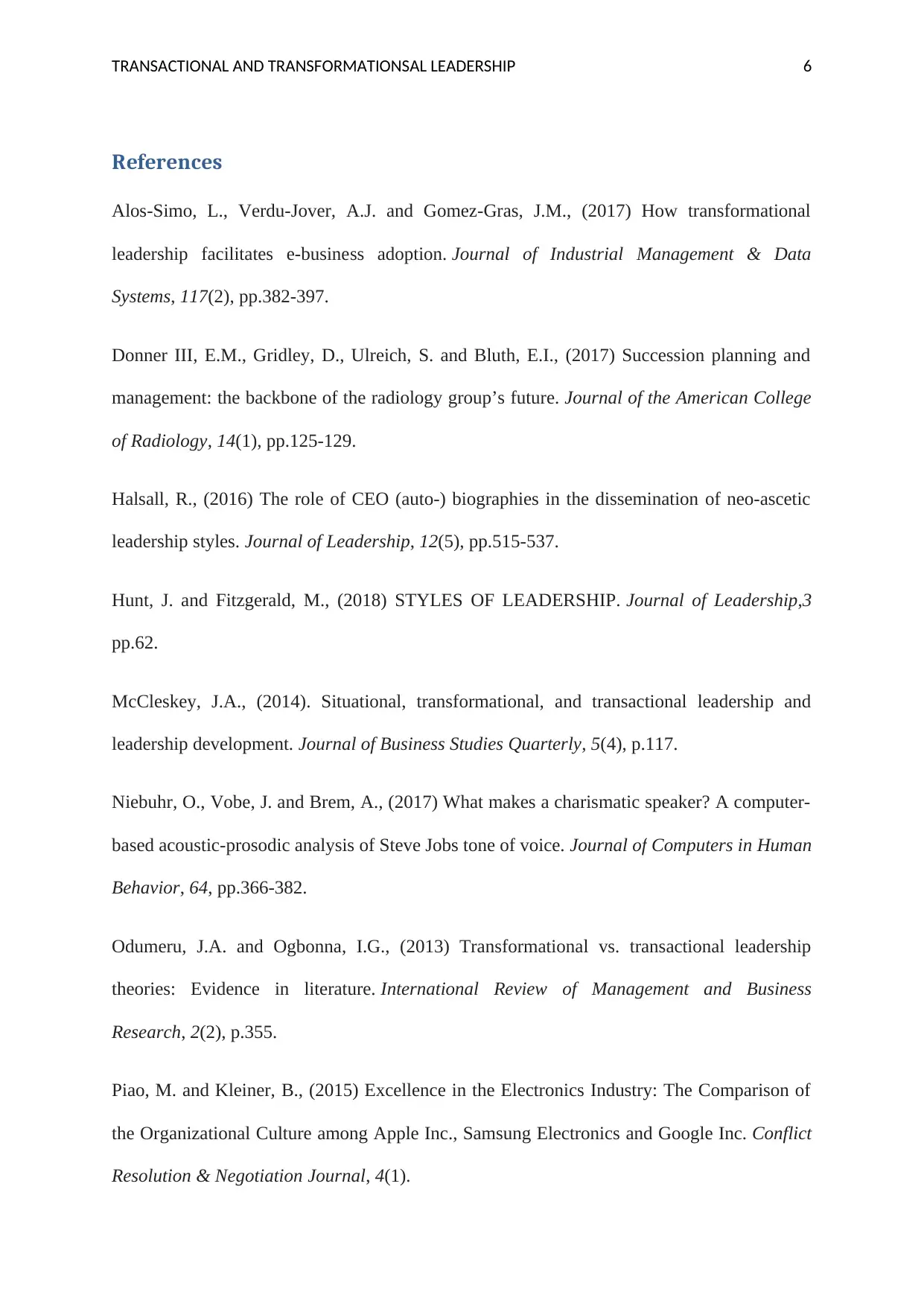
TRANSACTIONAL AND TRANSFORMATIONSAL LEADERSHIP 6
References
Alos-Simo, L., Verdu-Jover, A.J. and Gomez-Gras, J.M., (2017) How transformational
leadership facilitates e-business adoption. Journal of Industrial Management & Data
Systems, 117(2), pp.382-397.
Donner III, E.M., Gridley, D., Ulreich, S. and Bluth, E.I., (2017) Succession planning and
management: the backbone of the radiology group’s future. Journal of the American College
of Radiology, 14(1), pp.125-129.
Halsall, R., (2016) The role of CEO (auto-) biographies in the dissemination of neo-ascetic
leadership styles. Journal of Leadership, 12(5), pp.515-537.
Hunt, J. and Fitzgerald, M., (2018) STYLES OF LEADERSHIP. Journal of Leadership,3
pp.62.
McCleskey, J.A., (2014). Situational, transformational, and transactional leadership and
leadership development. Journal of Business Studies Quarterly, 5(4), p.117.
Niebuhr, O., Vobe, J. and Brem, A., (2017) What makes a charismatic speaker? A computer-
based acoustic-prosodic analysis of Steve Jobs tone of voice. Journal of Computers in Human
Behavior, 64, pp.366-382.
Odumeru, J.A. and Ogbonna, I.G., (2013) Transformational vs. transactional leadership
theories: Evidence in literature. International Review of Management and Business
Research, 2(2), p.355.
Piao, M. and Kleiner, B., (2015) Excellence in the Electronics Industry: The Comparison of
the Organizational Culture among Apple Inc., Samsung Electronics and Google Inc. Conflict
Resolution & Negotiation Journal, 4(1).
References
Alos-Simo, L., Verdu-Jover, A.J. and Gomez-Gras, J.M., (2017) How transformational
leadership facilitates e-business adoption. Journal of Industrial Management & Data
Systems, 117(2), pp.382-397.
Donner III, E.M., Gridley, D., Ulreich, S. and Bluth, E.I., (2017) Succession planning and
management: the backbone of the radiology group’s future. Journal of the American College
of Radiology, 14(1), pp.125-129.
Halsall, R., (2016) The role of CEO (auto-) biographies in the dissemination of neo-ascetic
leadership styles. Journal of Leadership, 12(5), pp.515-537.
Hunt, J. and Fitzgerald, M., (2018) STYLES OF LEADERSHIP. Journal of Leadership,3
pp.62.
McCleskey, J.A., (2014). Situational, transformational, and transactional leadership and
leadership development. Journal of Business Studies Quarterly, 5(4), p.117.
Niebuhr, O., Vobe, J. and Brem, A., (2017) What makes a charismatic speaker? A computer-
based acoustic-prosodic analysis of Steve Jobs tone of voice. Journal of Computers in Human
Behavior, 64, pp.366-382.
Odumeru, J.A. and Ogbonna, I.G., (2013) Transformational vs. transactional leadership
theories: Evidence in literature. International Review of Management and Business
Research, 2(2), p.355.
Piao, M. and Kleiner, B., (2015) Excellence in the Electronics Industry: The Comparison of
the Organizational Culture among Apple Inc., Samsung Electronics and Google Inc. Conflict
Resolution & Negotiation Journal, 4(1).
Paraphrase This Document
Need a fresh take? Get an instant paraphrase of this document with our AI Paraphraser
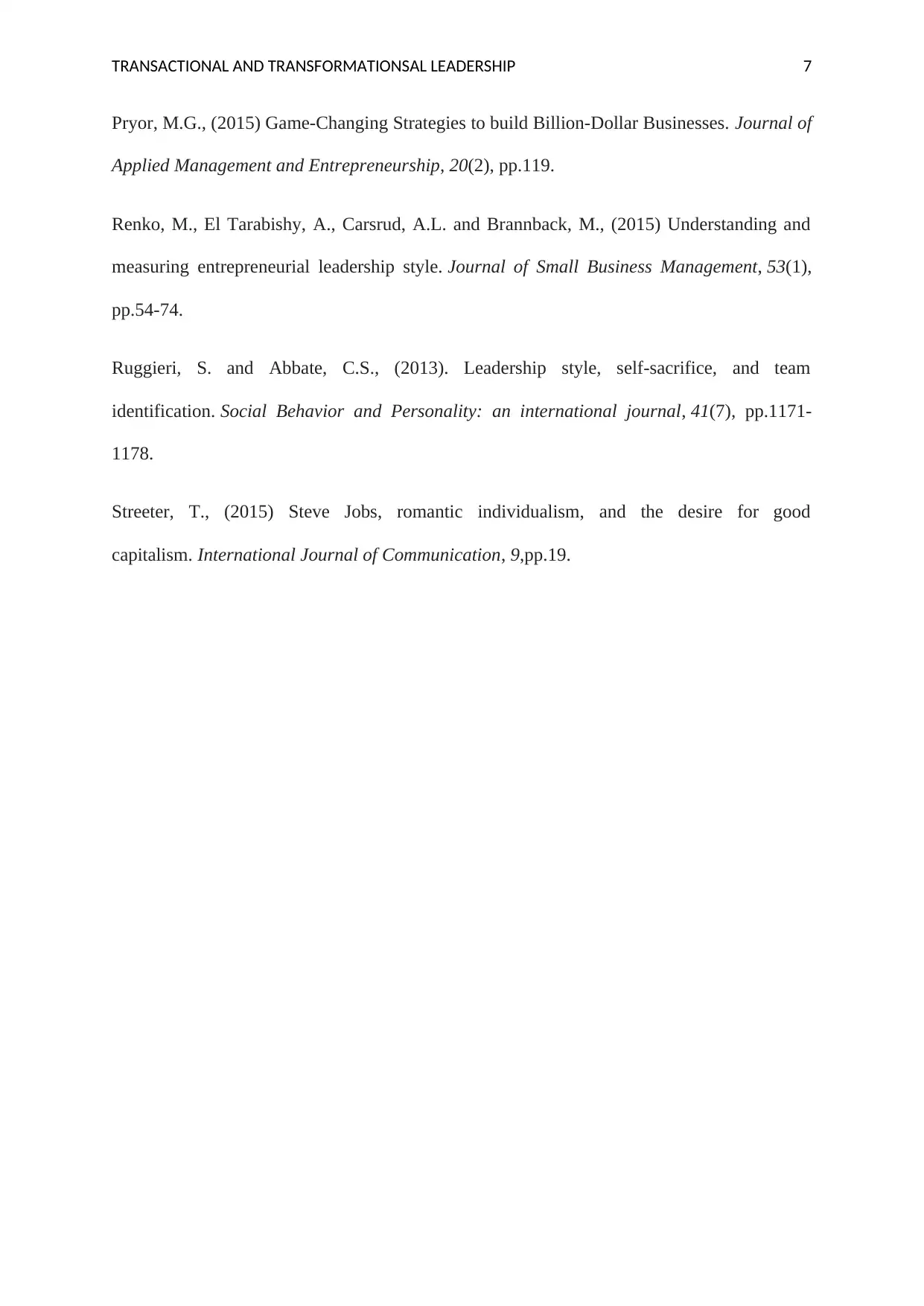
TRANSACTIONAL AND TRANSFORMATIONSAL LEADERSHIP 7
Pryor, M.G., (2015) Game-Changing Strategies to build Billion-Dollar Businesses. Journal of
Applied Management and Entrepreneurship, 20(2), pp.119.
Renko, M., El Tarabishy, A., Carsrud, A.L. and Brannback, M., (2015) Understanding and
measuring entrepreneurial leadership style. Journal of Small Business Management, 53(1),
pp.54-74.
Ruggieri, S. and Abbate, C.S., (2013). Leadership style, self-sacrifice, and team
identification. Social Behavior and Personality: an international journal, 41(7), pp.1171-
1178.
Streeter, T., (2015) Steve Jobs, romantic individualism, and the desire for good
capitalism. International Journal of Communication, 9,pp.19.
Pryor, M.G., (2015) Game-Changing Strategies to build Billion-Dollar Businesses. Journal of
Applied Management and Entrepreneurship, 20(2), pp.119.
Renko, M., El Tarabishy, A., Carsrud, A.L. and Brannback, M., (2015) Understanding and
measuring entrepreneurial leadership style. Journal of Small Business Management, 53(1),
pp.54-74.
Ruggieri, S. and Abbate, C.S., (2013). Leadership style, self-sacrifice, and team
identification. Social Behavior and Personality: an international journal, 41(7), pp.1171-
1178.
Streeter, T., (2015) Steve Jobs, romantic individualism, and the desire for good
capitalism. International Journal of Communication, 9,pp.19.
1 out of 8
Related Documents
Your All-in-One AI-Powered Toolkit for Academic Success.
+13062052269
info@desklib.com
Available 24*7 on WhatsApp / Email
![[object Object]](/_next/static/media/star-bottom.7253800d.svg)
Unlock your academic potential
© 2024 | Zucol Services PVT LTD | All rights reserved.





